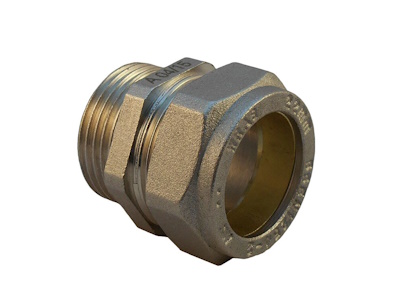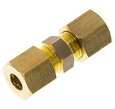How To Fix a Leaking Compression Fitting

Figure 1: Compression fitting
A compression fitting connects two pipes or connects a pipe to a fixture. It has three main parts: a compression seat, a nut, and a ring. A compression fitting can leak if one of these pieces isn't correctly installed or becomes damaged. This article discusses the main causes of leaks in compression fittings and how to fix them.
Table of contents
- Causes of leaks
- How to seal a leaking compression fitting
- Replacing a compression fitting
- Pressure test
- FAQs
View our online selection of fittings!
Causes of leaks
Compression fittings can leak for multiple reasons, such as improper usage, installation issues, or overpressure.
Improper use
- Stationary connections: Use compression fittings only on stationary connections, meaning the pipes/fixtures connected to the compression fitting should not move back and forth.
- Overtightening: Overtightening a compression fitting can cause leaks. While adjusting the compression fitting, turn the tool until resistance is felt. Turn at most half a rotation beyond this point. This method effectively prevents the fitting from leaking.
Incorrect assembly
When installing the compression fittings onto the pipe, it is crucial to insert it completely. If the fitting isn't fixed correctly, it won't establish a fully sealed connection, leading to leakage. There may be resistance when pushing the pipe in, but this does not necessarily indicate that the pipe is fully inserted. Remove the pipe, mark the halfway point, and use this as a guide for insertion. Push the pipe in until the mark reaches the edge of the fitting or until it aligns with a reference point on the fitting itself. This ensures that the pipe is inserted to the correct depth, establishing a fully sealed connection and minimizing the risk of leakage. Read our article on assembling compression fittings for more details on using a compression fitting for an application.
Pressure is too high
High pressure levels on the fittings can cause leaks, especially if the connection involves a pipe or fitting at an angle. This pressure could distort the o-ring, impairing its functionality and possibly leading to leakage. Plasson compression fittings and high-pressure compression fittings are designed to handle high strain levels and prevent leaks by:
- Distributing pressure evenly across the fitting
- Using a high-quality o-ring that is resistant to distortion
This makes them ideal for various applications, including connecting pipes or fittings at an angle.
Pipe complications
Achieving a completely sealed connection becomes difficult if the pipe end is rough or uneven. Consequently, ensuring the pipe has a clean, straight cut is essential. Use a pipe cutter rather than a blade or saw to prevent this issue.
How to seal a leaking compression fitting
The optimal solution to fixing a compression fitting leak is to loosen and then tighten the compression nut. This will break up the corrosion on the nut threads, creating a tighter seal. Before doing this, turn the main shutoff valve off and ensure the water supply is turned off. Also, keep a dry towel and bucket handy to collect any water that might leak out when you loosen the nut. After securing the fitting, turn the water back on and check for leaks. If the leakage persists, replace the compression fitting.
Replacing a compression fitting
Before replacing the compression fitting, turn off the water by closing the inlet valve.
- Disassemble the old compression fitting. Utilize a pair of standard pliers to grip and hold the male end of the compression fitting. While maintaining a steady hold, use another pair of pliers to rotate the compression nut counter-clockwise with the free hand.
- Once the nut is loosened, manually unscrew it the rest of the way until the fitting is completely detached.
- Use a pair of pliers to grip the compression ring. Carefully twist it with the pliers to loosen it. Pull it off once it's loose.
- After removing the nut, use a file to smooth out the end of the pipe to remove any burrs. Proceed to remove the old compression nut and introduce the new nut, ring, and seat onto the end of the pipe. Tighten everything up and then restore the water supply.
Note: If turning off the water supply is not possible, try freezing the pipe temporarily (using aerosol sprays or electrical freezing kits) to replace the compression fitting.
Additional tips
Sometimes, removing an existing compression fitting may not be straightforward, and the nut might need to be physically cut off. If this is required, use a hacksaw. Ensure to cut as close to the rear of the nut as possible.
Use pipe dope or plumber's grease when replacing the compression fitting. It's advisable not to use Teflon tape on compression fittings as it can keep the compression nut from screwing down enough to form a waterproof seal successfully.
Pressure test
- Pressure testing ensures that compression fittings are properly installed, reducing the risk of leaks and potential damage. After installation, isolate the connected plumbing section, and introduce pressurized water or air. The pressure should align with the system's intended operating pressure but is usually higher for the test (check local codes for specific requirements).
- Inspect the compression fittings, joints, and nearby connections for any visible signs of water or air escaping. This includes looking for drips, bubbles, or damp spots.
- Listen for hissing sounds that might indicate air or water escaping from the system.
- Use a pressure gauge to ensure the pressure remains within the expected range. A pressure drop suggests a leak in the system.
- If leaks are detected, immediately shut off the supply and address the problem, often involving inspection and reassembly. Repeat the test after repairs and periodically to ensure system integrity.
FAQs
Are compression fittings reliable?
Compression fittings are reliable when installed correctly, but maintenance and proper installation are crucial for leak-free performance.
Why is my compression fitting leaking?
A compression fitting may leak due to overtightening, improper installation, damaged components, or worn-out seals.
How do I stop my compression fitting from leaking?
Prevent compression fitting leaks by proper installation, avoiding overtightening, and inspecting for damage. Replace if the leak persists.
Are compression fittings reusable?
Compression fittings are often reusable if undamaged and properly disassembled, but it's advisable to replace them to ensure a secure seal.










